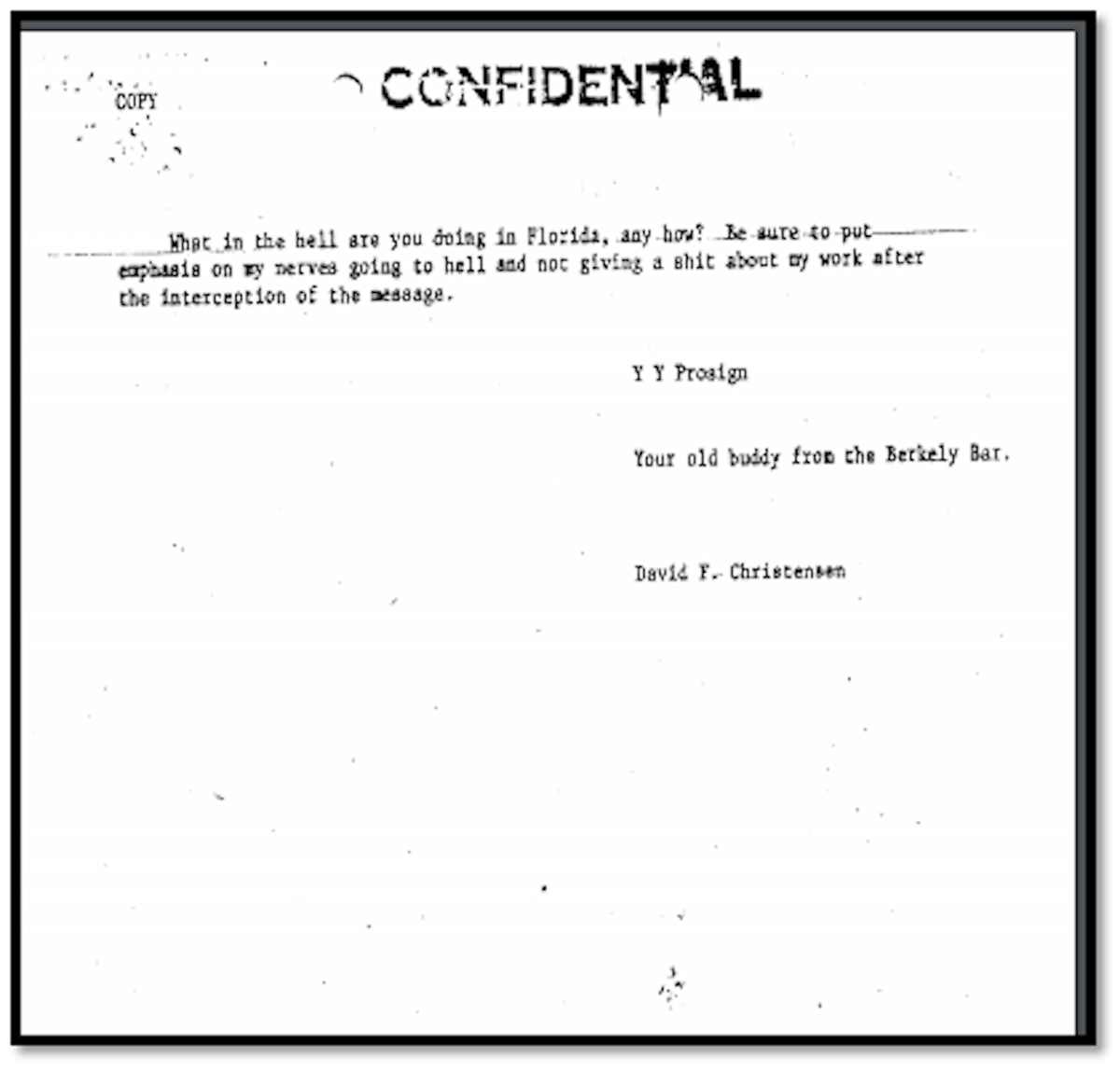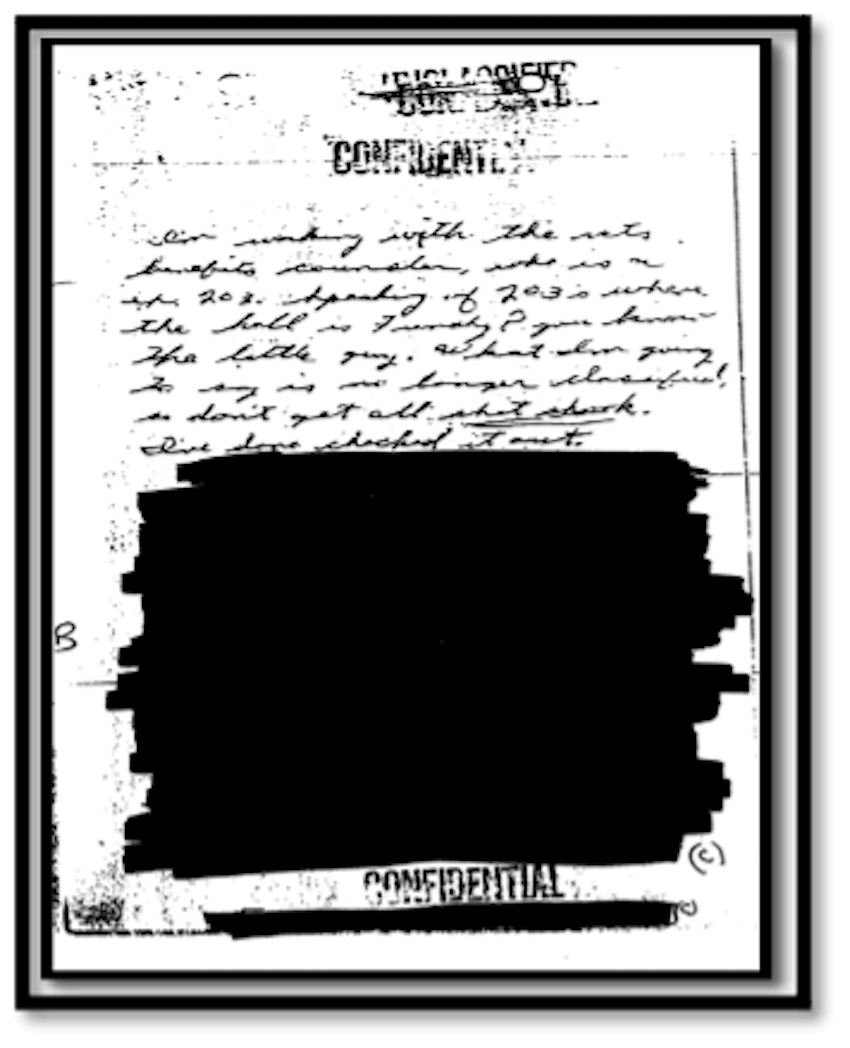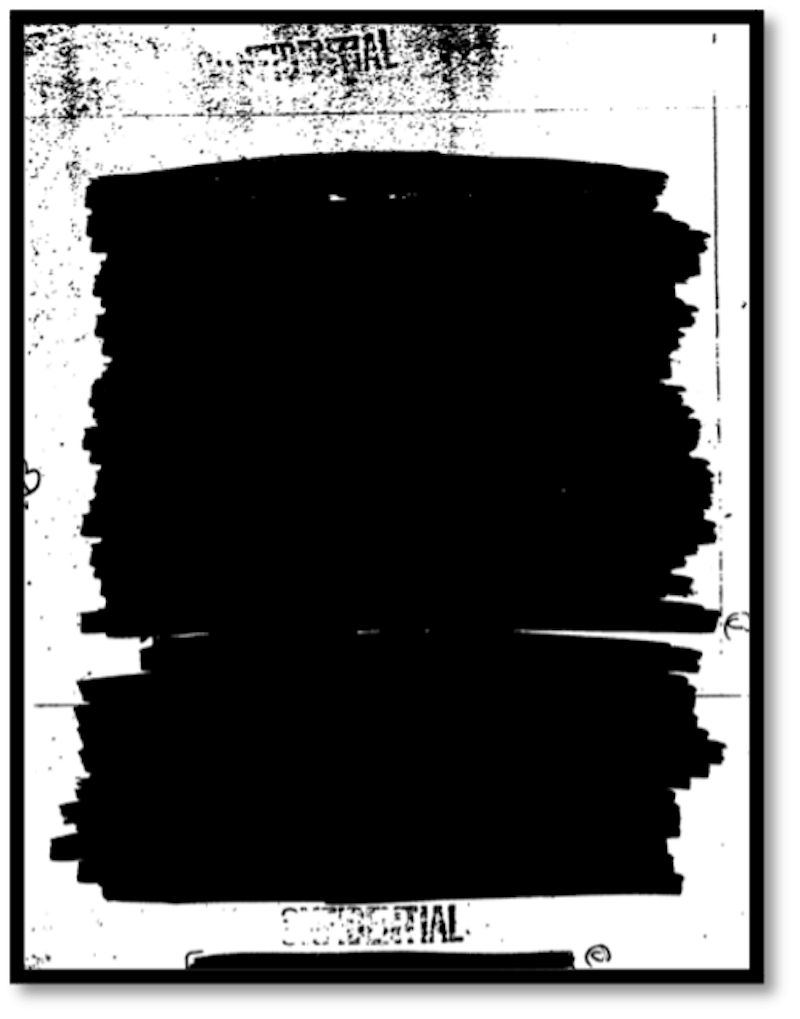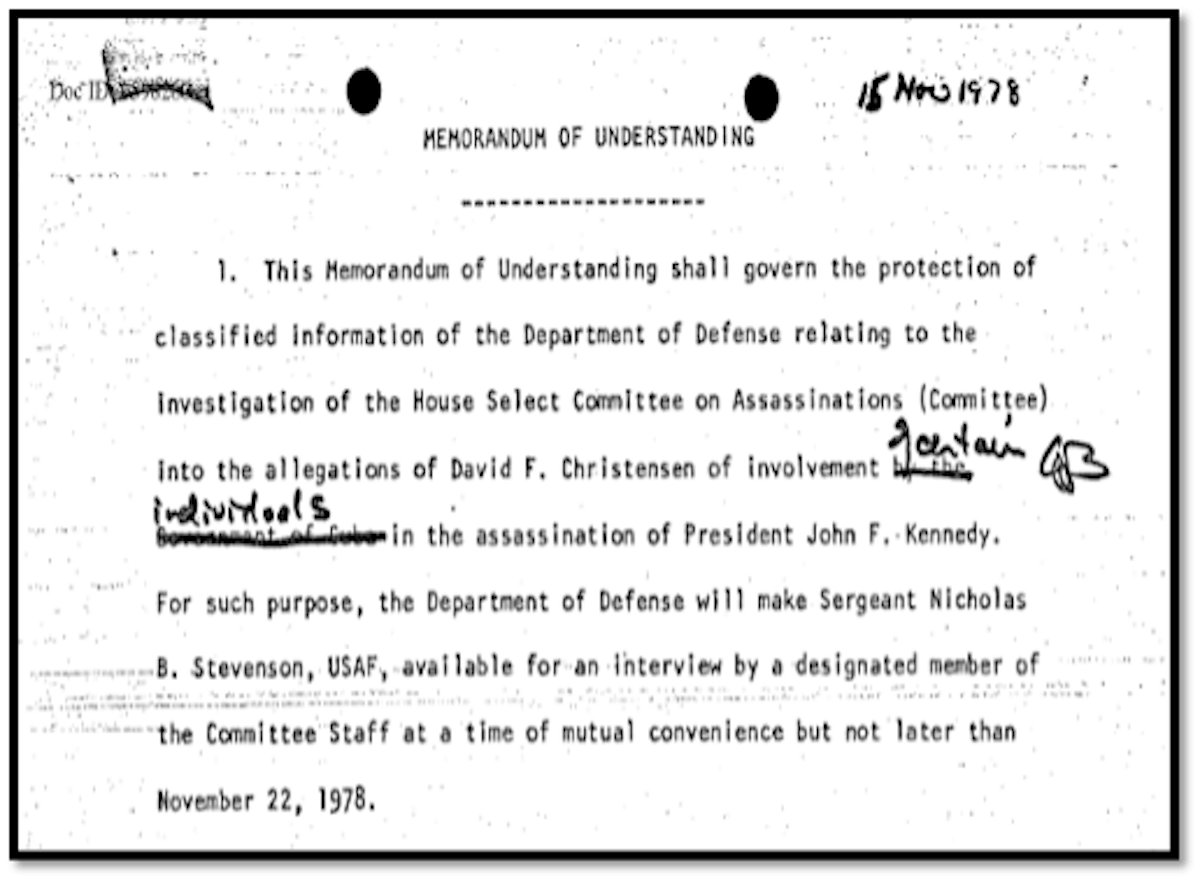Did a US Air Force Security Service Member Intercept a Communication
Predicting the JFK Assassination?
The time is October 1963. The place is an Air Force Base in Kirknewton (Scotland), located approximately 11 miles west of the capital city, Edinburgh. A US Air Force (USAF) Security Service member is carrying out his regular duties at the base. Although it is in the United Kingdom, the base is currently under the control of the USAF Security Service. His duties include monitoring and reporting intelligence communication traffic to his supervisors. They then relay this information on to the National Security Agency (NSA) Headquarters in Fort Meade, Maryland. The individual’s name is David Christensen.
Christensen is listening to communications coming out of Lisbon, the capital of Portugal. Suddenly, he eavesdrops on a link between Lisbon and Tangier (Morocco) that mentions a high-ranking figure in organized crime and the assassination of President John F. Kennedy. Recognizing the importance and gravitas of such an intercept, he immediately informs his supervisors, confident in the knowledge that they will pass the information up the chain of command.
Christensen had done his duty. He was relieved. He may even have felt that because of the important content of the intercept, it would have been given Critical Intelligence Communications status, otherwise known as CRITIC. Such messages should be alerted to the President and other senior government officials within minutes, if possible.
A few weeks later, when Christensen heard the news of President Kennedy’s assassination in Dallas on 22 November 1963, his heart sank. His life then followed a similarly low trajectory. As he said himself, in a letter he wrote in May 1978, to a fellow officer who served with him at the RAF Kirknewton base, “it really broke me up after Nov. 22, 63 especially when I had it all beforehand.” We will return to this letter shortly.
Was David Christensen destined to become another accidental witness to history, having had prior knowledge of the JFK assassination, alerting the appropriate authorities who then did nothing and failed to protect the President?
This is his story and how it was eventually brought to the attention of the House Select Committee on Assassinations (HSCA) in 1978.
David Christensen and RAF Kirknewton
David Frederick Christensen was born on 26 January 1942 in the midwestern town of Dickinson, North Dakota. He grew up on a ranch near the town of Halliday, which was about 40 miles north east from the town of his birth. Christensen graduated from High School in Halliday in 1960 and married that same year. The young Christensen quickly joined the USAF and in 1961 was sent overseas to the RAF Kirknewton base in Scotland.
The small town of Kirknewton has a population of just over 2,000. During World War II, a military airfield was built about a mile south of the town by the British Royal Air Force (RAF). Unsurprisingly, it was named RAF Kirknewton.
The base began life as a grass airfield in late 1940. Its initial purpose was to provide a home for the 289 Squadron in November 1941. The 289 Squadron was an anti-aircraft operation unit who eventually relocated to another base around six months later. RAF Kirknewton was then used for a variety of purposes, including a short stint as a Refresher Flying Training School, which helped to prepare inactive pilots for postings to operational training units.
In 1943, there was some hope that the RAF Kirknewton base would replace the RAF Findo Gask station, when that base became unserviceable. Findo Gask was situated 50 miles north of Kirknewton. That hope quickly evaporated however when RAF Kirknewton did not obtain the necessary clearance to build runway extensions, probably because of dangerous crosswinds in the area.
From the 1950s onwards, RAF Kirknewton was no longer used for aviation and in early 1952, the base was handed over to the USAF Security Service––the intelligence branch of the USAF. RAF Kirknewton then began a new life as a strategic US intelligence listening station that was used by the Central Intelligence Agency (CIA) and NSA to eavesdrop on military and commercial naval traffic, with priority given to Soviet radar. The Cold War was really heating up at this point. Personnel at the base included radio operators, linguists, and analysts––many with Top Secret and higher security clearance.
The planning for this phase in the life of RAF Kirknewton actually began in August 1951 at the Brooks Air Force Base in San Antonio, Texas when the 37th Radio Squadron Mobile (RSM) was activated. This unit was then selected to move to the UK and into the RAF Kirknewton base.
Ironically, President Kennedy’s last official act as President was at the Brooks Air Force Base on 21 November 1963, when he opened and dedicated the new Aerospace Health Medical Centre there.
Around May/June 1952, the first personnel arrived in Scotland (via a three month stay in Bremerhaven, Germany for background investigations and security clearances). These first arrivals referred to Scotland as the “land of the heather, the moors, Scotch whiskey and the kilt.”
The 37th RSM began formal operations at Kirknewton in August 1952 and by the following month the base had grown in size, with around 17 officers and 155 airmen in post. During its first year, RAF Kirknewton was used to evaluate antenna configurations, with the aim of determining the most effective configuration for intercepting Soviet communications and radar signals.
The formal transfer of RAF Kirknewton from the British air ministry to the USAF had already taken place by 27 March 1953. Two years later, the 37th RSM was re-designated as the 6952nd RSM, but there was no change to the original mission.
At the peak of its activity, RAF Kirknewton housed 17 officers and 463 airmen. Over 2,000 personnel served during the lifespan of the base. Towards the end of its life as a listening station, the base was even responsible for maintaining security over part of the hotline established in 1963 between Washington and Moscow, as the cable route passed through the area. The base was handed back to Britain in 1967.
In James Bamford’s book, The Puzzle Palace (Penguin Books, 1983, page 270), we get an insight into the type of work Christensen would have been performing at Kirknewton. An unnamed former employee explained his routine at the base:
Intercepted telegrams came through on telex machines. I was provided with a list of about 100 words to look out for. All diplomatic traffic from European embassies was in code and was passed at once to a senior officer. A lot of telegrams––birthday congratulations for instance––were put into the burn bag. I had to keep a special watch for commercial traffic, details of commodities, what big companies were selling, like iron and steel and gas. Changes were frequent. One week I was asked to scan all traffic between Berlin and London and another week between Rome and Belgrade. Some weeks the list of words to watch for contained dozens of names of big companies. Some weeks I just had to look for commodities. All traffic was sent back to Fort Meade in Washington.
As “all traffic was sent back to Fort Meade in Washington” you would have thought that an intercept referring to the assassination of the President would have been given priority treatment and not “put into the burn bag” with birthday messages!
Christensen’s Letter and Subsequent Investigation
Earlier, I referred to a letter David Christensen wrote to an ex-colleague in May 1978. The recipient of his letter was Sergeant Nicholas Stevenson, who served two tours of duty at RAF Kirknewton. The second tour was between June 1962 and June 1965, so he was based there at the same time Christensen said he picked up the Lisbon/Tangier intercept. We can see here a typed copy of the letter provided to the HSCA by the NSA in 1978 (click here to see the original handwritten version of Christensen’s letter).
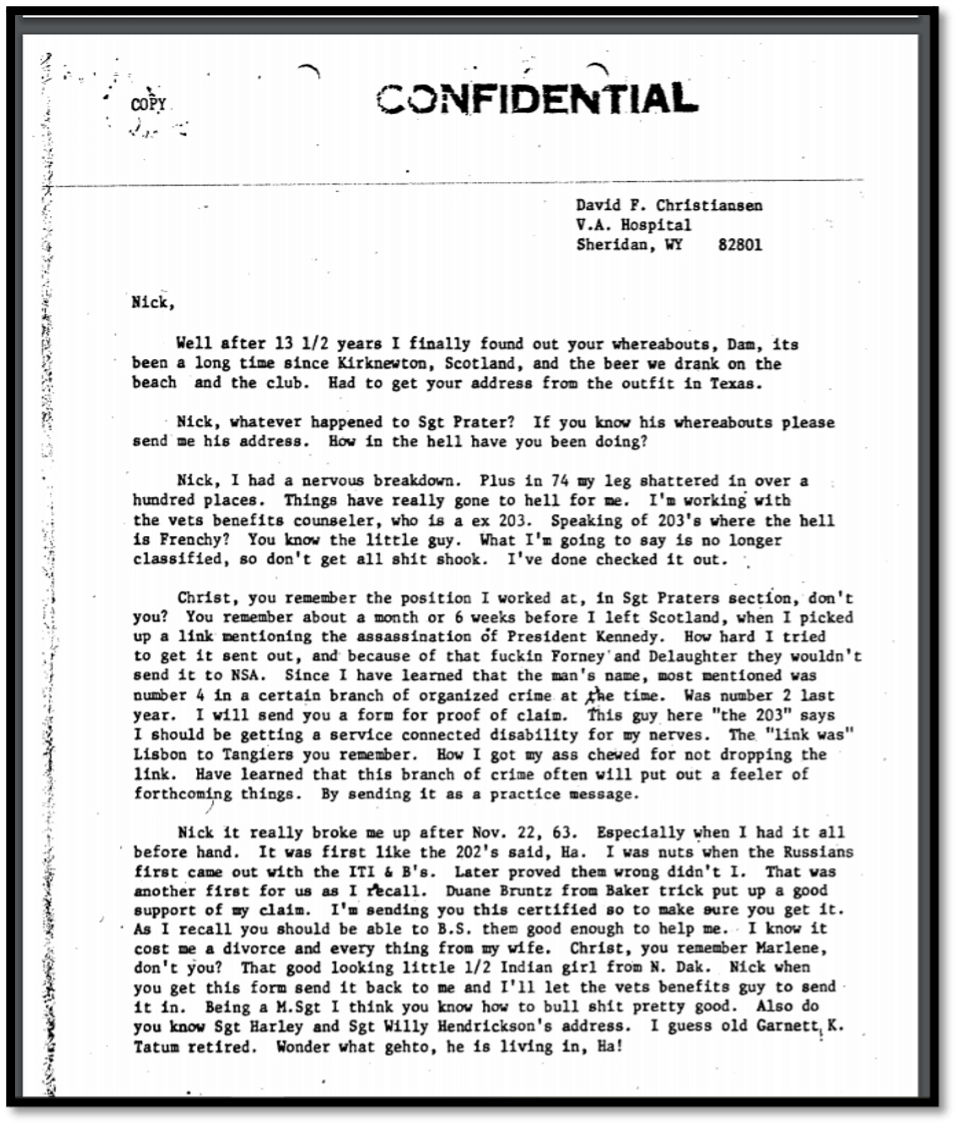
Unlike his alert to senior officers in October 1963, Christensen’s letter to Stevenson did not fly under the radar. It was quickly brought to the attention of US government agencies and eventually the HSCA, led by Chief Counsel G. Robert Blakey.
When Christensen wrote the letter, he was in a Veterans Hospital in Sheridan, Wyoming. Stevenson was based at Corry Field, Florida.
An earlier public release of the letter contained many redactions. This is what two of the pages looked like––clearly there were concerns about the content:
Once Stevenson had read the letter, he alerted the USAF Security Service, who in turn notified the Office of Special Investigations (OSI). An OSI agent, based at the Lowry Air Force Base in Colorado, was assigned to contact Christensen, and interview him about the letter. This interview took place on or around 1 June 1978.
A letter dated 2 June 1978 from Paul Fisher (Chief, USAF Security Service) provides an insight into what was discussed between the OSI agent and Christensen. Fisher’s letter was addressed to James Lear, Director of the NSA (click here to see Fisher’s letter). He wrote that the purpose of the interview with Christensen was to determine the names of any other individuals he may have contacted. He went on to state that “Mr. Christensen has a long history of alcoholism, family problems and now wants to see a cleared psychiatrist as he attributes all of his problems from Oct 1963, per the OSI agent. In addition, he has indicated to the OSI that he now fears for his life.”
The government agencies at this point clearly seemed to be more concerned about who else Christensen may have talked to about the letter, rather than the actual claim made about the JFK assassination and organized crime. Christensen’s health and personal problems were also highlighted, a common tactic when trying to undermine someone’s credibility.
This illustrates that if Christensen did intercept a message in October 1963 predicting the JFK assassination, and tried to raise the alarm or alert authorities, then it had a very profound and damaging effect on his life. Something similar happened to Eugene Dinkin, Ralph Leon Yates, and Abraham Bolden to name just a few (click here for more on Eugene Dinkin).
On 7 September 1978, Daniel Silver (General Counsel, NSA) wrote to the FBI about the letter and provided them with a typed copy. Silver indicated that the FBI may wish to bring the matter to the attention of any Committee of the Congress. The HSCA had already been investigating the JFK assassination for two years by then (click here to see Silver’s letter).
Interestingly, Silver also corroborated a central claim made in Christensen’s letter about what was going on at the RAF Kirknewton base in October 1963.
Silver wrote that “the information contained in Mr. Christensen’s letter that the Air Force Security Service was intercepting international commercial communications at Kirknewton, Scotland in 1963 is correct, as is the assertion that the station monitored communications links between Lisbon and other parts of the world.” As we will discuss later, other facts raised by Christensen in his letter can also be corroborated.
The HSCA were indeed made aware of Christensen’s claim and on 8 November 1978, Chief Counsel Blakey met with a representative of the NSA to discuss further. The memorandum written up from this meeting confirmed that Christensen had been committed to “a mental institution” because of the October 1963 intercept. Blakey posed several questions to the NSA including what their capability was to retrieve communications from Kirknewton from the time period in question, and whether Christensen really was working for the USAF at the time and doing the kind of work consistent with “intercepting commercial communications.”
Blakey followed this up on 15 November 1978 by writing to Harold Brown who was then Secretary of Defense under President Jimmy Carter. Brown had also worked in the Defense Department under Robert McNamara during JFK’s time in the White House.
On the same date, a memorandum of understanding was also drawn up and signed by both Blakey and John Kester, who was the Special Assistant to the Secretary and Deputy Secretary of Defense. The purpose of the memorandum was in relation to the Defense Department’s agreement to release Sergeant Stevenson to be interviewed by the HSCA. It included the restrictions placed on them in this regard, such as that it be limited in scope to the allegations made by Christensen, no classified information would be disclosed by the HSCA without the written consent of the Defense Department, and that Stevenson would be accompanied at the interview.
What is also interesting about the memorandum of understanding was an error in the original typed copy. As we can see, it referred to “the allegations of David F Christensen of involvement by the Government of Cuba in the assassination of President John F. Kennedy.” This was then scored out, initialed and corrected to read “of certain individuals.”
Click here to see the full memorandum of understanding.>
There is no record that Christensen made any allegation that the Government of Cuba was involved in the JFK assassination. I’m sure this mistake was just an honest clerical error!
The Interview with Sergeant Stevenson
The interview with Sergeant Nicholas Stevenson took place on 17 November 1978 in the Senate Intelligence Committee room. Two HSCA staff members conducted the session. They were Gary Cornwell and Kenneth Klein. Stevenson was accompanied by a legislative liaison officer from the USAF. Others in attendance included Eugene Yeates, Chief of Legislative Affairs at the NSA.
I have been unable to find a verbatim account of what was discussed but a summary of the interview was subsequently written up by Klein that day (click here to see Klein’s report) and by Yeates in a memorandum dated 21 November 1978 (click here to see Yeates’ memorandum).
At the meeting, Stevenson confirmed that he had known Christensen for a number of years and recognized other names in the letter. He added that he could not rule out that such a message was picked up at RAF Kirknewton but felt it would have been more widely known at the base and be the probable subject of a CRITIC. We have seen previously that this relates to a piece of Critical Intelligence Communications which should be treated with the utmost urgency and importance. Stevenson denied any specific knowledge of the allegation made concerning organized crime and the assassination of the President.
HSCA investigator Cornwell suggested to Stevenson that he call Christensen to find out the name of the figure in organized crime. Stevenson replied that he was unwilling to do so. In Klein’s report, it is stated that the lawyer representing Stevenson, stated that “such a phone call could only be arranged through the Department of Defense.”
It has always puzzled me why the HSCA did not pursue more vigorously the name of the organized crime figure mentioned in Christensen’s letter. The memorandum by Eugene Yeates stated that “the staffers remain particularly interested in determining the name of the individual who Mr. Christensen believes relates to the assassination” and ended with the words “If the Committee is able to determine a specific name, the staffers indicated that they would probably initiate a specific inquiry to NSA to again search our materials.”
There is no available information that I have yet been able to find that the HSCA made any serious further efforts to determine the identity of the individual. Despite what Stevenson’s lawyer said, I would have thought the HSCA would have moved heaven and earth to find out the name of the organized crime figure, particularly as Chief Counsel Blakey was pointing the figure of suspicion for the assassination at organized crime. I also realize at the time (November 1978) that the HSCA and their Congressional investigatory mandate was due to run out at the end of the year. I accept that they may have had higher priorities to pursue at the time, such as the acoustical evidence from the Police Officer’s dicta-belt, that recorded the shots in Dealey Plaza.
Author, Larry Hancock, did speak to Sergeant Nicholas Stevenson for his excellent book Someone Would Have Talked (JFK Lancer Productions & Publications, 2010 edition, page 367). Stevenson told Hancock that “he was unable to discuss the subject because of two brain operations which had totally eliminated all of his past memories.”
On 21 November 1978, Eugene Yeates wrote a further letter to confirm that the NSA had “made a thorough search of all records” pertinent to the allegation made by Christensen and that “no communications or information relating to the Committee’s request” had been located. This letter was only released in full in November 2017 under the JFK Records Collections Act 1992 (click here to see the letter).
Another document only released in full at this time was from Harold Parish of the NSA. His memorandum was dated 2 January 1979. In it, Parish outlines the scope of the search conducted by the NSA to find materials relevant to the Kirknewton incident. He concluded that the NSA had “done all reasonable things to locate the reported intercept with negative results.” Just before concluding this, he also admitted that the search only really consisted of a look through three boxes from 1963 containing unidentified materials. There were nearly 10,000 products on file from January through November 1963 that would take a minimum of four weeks to go through (click here to see the memorandum).
The reality of the search is underlined by another memorandum dated 13 December 1978, this time by C. Baldwin of the NSA (click here to see the memorandum). Baldwin’s memo confirmed “that a review of the documents in these three unidentified boxes would constitute a reasonable effort to find the alleged record” and that the “latest date in the box was 1962.” We know Christensen’s intercept was made in October 1963.
Baldwin’s memo goes on to state that Mr. Sapp of the NSA “requested that an additional search be made of materials dated later than 1963” but that after reviewing the listing of such boxes, “nothing on the list merits such a search.”
It is clear to me that the NSA’s response, that they had made a “thorough search” to locate information relating to Christensen’s allegation, was disingenuous at best and a complete fabrication at worst. It also makes me wonder why these documents were hidden from public view for nearly 40 years if there was nothing to see. I appreciate that time is precious for government agencies but maybe in the near future, I’ll get the opportunity to make a more “thorough search” of these materials. I look forward to that day.
The Lisbon and Tangier Link
The intelligence agencies and HSCA seemed to have closed the book insofar as David Christensen’s allegation was concerned.
You will recall that he mentioned that the link picked up was between Lisbon and Tangier. We have seen that the NSA confirmed that they were indeed listening to communications between Lisbon and other parts of the world at the time Christensen was based at RAF Kirknewton.
Lisbon and Tangier are only about 275 miles apart. They are both interesting places to research. Both are port cities with easy access to North Africa, Southern Europe and a gateway to the Atlantic.
Lisbon was known as the Capital of Espionage during World War II, largely because Portugal was officially neutral during that bloody conflict. Like its neighbour Spain, Portugal was ruled by a fascist dictator for decades. Antonio de Oliveira Salazar held power from 1932 until 1968. But because of the country’s neutrality during the war, Lisbon became a haven for spies. Intelligence agents from the allies and axis countries all converged on Lisbon.
After the war, many organizations continued to take advantage of Salazar’s anti-communist dictatorship. These included CIA-NATO sponsored “Gladio” stay behind units, set up allegedly to defend Western Europe from a possible Soviet invasion, but who ended up inflicting murder and terrorist attacks on their own populations to instill fear, and frame political opponents. James Earl Ray also spent around ten days in Lisbon just before his arrest in London in June 1968 for the alleged murder of Martin Luther King Jr.
Tangier was an important trade centre and international zone from 1924 until it was integrated into Morocco in 1956. It was also a place where spies met and even the setting for part of a James Bond film in the 1980’s! Bond author, Ian Fleming, was a friend of JFK’s. Smuggling was a popular pastime, if we can describe it as that. There were also several alleged sightings of Lee Harvey Oswald in Tangier, but I am sceptical of their authenticity. I could write a separate article about this subject alone!
An interesting character who we do know was in Tangier was Thomas Eli Davis III. He was an associate of Jack Ruby and in the gun running business, which included Cuba. In fact, it is reported that Ruby’s first lawyer, Tom Howard, asked his client whilst he was awaiting trial for Oswald’s murder if there was anybody who could harm his defence if it came out at the trial. Ruby mentioned Thomas Eli Davis.
Davis was arrested in Tangier on 8 December 1963 for trying to sell two pistols to raise money. What concerned the Moroccan police more though was that Davis also had in his possession a cryptic, unsigned letter in his handwriting that mentioned Oswald and the Kennedy assassination. It is likely though that the reference to Oswald was a Victor Oswald, an arms dealer that Davis met in Madrid around November 1963.
Another, and possibly more interesting bit of information about Davis, is that he was in custody in Algiers, Algeria on the day of the JFK assassination for running guns to the violent Organisation Armée Secrète, commonly known as the OAS. The OAS were opposed to Algerian independence from France (which was won in March 1962) and had tried to assassinate President De Gaulle on numerous occasions because of his stance on Algeria. They also had a station in Madrid.
According to author Seth Kantor, Davis’s release from custody in Algiers was facilitated by a CIA asset with the cryptonym QJ/WIN (The Ruby Cover-Up, Zebra Books, 1978, page 45). This mysterious individual was part of the ZR/RIFLE Executive Action assassination programme led by William Harvey, who hated Kennedy and Castro. Could Harvey’s programme have diverted its attention towards JFK?
Anti-Castro Cuban refugees were also known to have left their country of birth and made their way to Tangier because of the Castro revolution.
The connection between Lisbon and Tangier may not therefore have been as benign as one may originally think. It does not seem unreasonable that communications and intelligence chatter could have been picked up around October 1963 that included talk of the imminent assassination of JFK.
The Figure in Organized Crime
Earlier in the article, we saw the letter that Christensen wrote in 1978. He wrote that “the man’s name most mentioned was number 4 in a certain branch of organized crime at the time. Was number 2 last year.”
You don’t need to have the detective powers of Sherlock Holmes or Jessica Fletcher to work out that the person mentioned in the intercept therefore had to still be alive in 1977, the year before the letter was written––and was the number 2 man in that branch of organized crime.
When we talk about organized crime and the JFK assassination, there are three names that generally come top of most people’s lists. They are Carlos Marcello from Louisiana, Sam Giancana from Chicago and Florida kingpin, Santo Trafficante Jr. All are on record as wishing harm on President Kennedy, and his brother Bobby, and all had the means, motive and opportunity to do so.
Giancana though was brutally murdered himself in June 1975, so this would appear to rule him out as the person in the letter. Other high-profile Mafia figures who have been linked with the JFK assassination over the years include Joseph Civello (Dallas), Jimmy Hoffa (Teamsters Union), Johnny Roselli (CIA/Mafia Castro hits) and Antoine Guerini (Marseille Mafia).
They were also all dead by 1977 (or in Hoffa’s case had disappeared). Antoine Guerini’s equally notorious brother, Barthélemy, was sentenced to twenty years in prison in 1969 and died in 1982. Suspected grassy knoll shooter, Lucien Sarti, was also dead, killed in a Mexico City shoot out in 1972. So, it is most unlikely that the man’s name mentioned in the letter, and who was number 2 in a certain branch of organized crime in 1977, could have been any of these men.
It seems credible that the branch of organized crime mentioned in the letter could have been the lucrative heroin drug smuggling trade––going through Marseille and into North America. The so-called French Connection. It was thriving in the early 1960s and therefore under intense scrutiny by some government agencies. Montreal was a key city in this drugs corridor, as they made their way from Europe to the USA. This makes Paul Mondolini a potential suspect. He was alive in 1977.
This is, of course, all speculation and it is easy to throw names around without any specific corroboration. As well as drug trafficking, there are many other “branches” of organized crime including murder and assassination. The list of potential candidates could therefore be very long. But I do not think it takes us much further forward to throw other names into the mix without evidence.
What we do know for sure is that there was an opportunity for the HSCA to find out the name of the person in Christensen’s letter, but they either didn’t have time or did not believe it worthy of further investigation. The NSA didn’t help with their poor excuse of a search for relevant records and information. Could they have been worried about where it might lead them?
An Officer and a Gentleman
It’s easy to forget that within all this talk of the JFK assassination, organized crime figures, and Cold War paranoia, that the whole Kirknewton incident really revolves around one man––David Frederick Christensen.
Only he really knows the whole story and may have taken his secrets to the grave. Christensen died on 22 December 2008. He was 66 years old and rests forever at the Halliday Cemetery in North Dakota.
Some may say that he made the whole story up, perhaps to engineer some medical and financial assistance he may have been looking for from government. What happened between October 1963 and May 1978 (when he wrote the letter to Stevenson) is also a mystery. Who else did he tell about it? Was pressure brought to bear on him to keep quiet? These questions remain unanswered for now and require further investigation.
What we do know is that it rarely ended well for people who bravely put their heads above the parapet and tried to sound a warning about the possible assassination of JFK.
For those who doubt Christensen’s story, it’s worth reflecting on some of the other points mentioned in his 1978 letter.
He included the names of other officers who served at RAF Kirknewton, such as Prater, Harley, and Hendrickson. A review of the alumni at the USAF RAF Kirknewton website confirms the existence of such named individuals who served there. The Berkely Bar in Edinburgh was an established drinking establishment for serving military personnel at the time. He had indeed married a girl call Marlene Burr in 1960 and they were later divorced. He refers to some people as 202s and 203s. A 202 was a Radio Traffic Analyst and a 203 a Language Specialist––work consistent with the RAF Kirknewton base at the time. Could the outfit in Texas have been a reference to the Brooks Air Force Base in San Antonio?
Amongst all these facts, I find it extremely unlikely that Christensen would then have thrown in a wild accusation about an intercept that mentioned the assassination of President Kennedy, unless it really did happen.
As we all continue to research different aspects of the JFK assassination, maybe more about the Christensen story will be revealed. It’s a pity more of the documents and details about the HSCA investigation were not released until after his death. We may have been able to find found out a lot more if they were released earlier.
What we should never lose sight of though is that David Christensen was a human being who served his country with distinction and received an honorable discharge. He was trusted with high security clearance and is not just a name to be read in documents.
He had two sons and six grandchildren––a family man. He enjoyed playing card games and worked in the oil business when he left the Air Force. And his life was profoundly affected following Kirknewton. As he said himself––“it really broke me up after November 22, 1963” and “it cost him a divorce and everything from his wife.”
Until evidence is presented to the contrary, perhaps we should also start referring to David F Christensen as another forgotten hero as far as the JFK assassination is concerned.
We must keep searching for the truth.
As JFK said himself once, “Things do not happen. Things are made to happen.”


